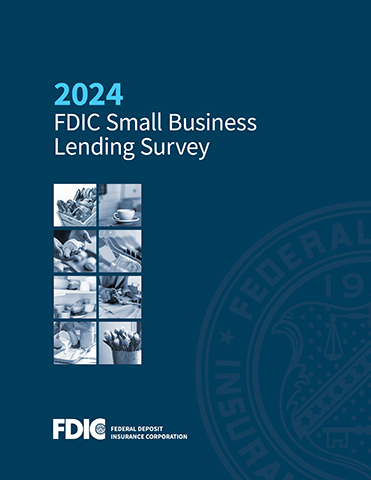
FDIC’s 2024 Report on the 2022 Small Business Lending Survey
The Small Business Lending Survey (SBLS) is a nationally representative survey that asks banks about their small business lending practices. Given the importance of small businesses to the U.S. economy and the importance of bank lending to small businesses, the FDIC conducted the SBLS in 2016 and in 2022 to meet a historical need for high-quality data on small business lending by banks. The findings from these surveys help regulatory agencies, policymakers, academics, and other stakeholders better understand how banks meet the credit needs of small firms.
The 2022 survey, conducted between June 2022 and January 2023, built on the success of the 2016 survey, which identified several areas for further analysis. For example, the 2022 survey delved more deeply into the fundamentals of loan underwriting and approvals, markets, and competition. The 2022 survey also covered new and timely topics such as the use of financial technology, the role of branches, and lending to start-ups. From a sample of 2,000 banks, about 1,300 banks—more than a quarter of all banks in the nation—responded, yielding a 68 percent survey response rate. This large and nationally representative sample allows for a comprehensive view of small business lending by banks.
Complete Report
Table of Contents
Acknowledgements
Executive Summary
Section 1: Introduction
Section 2. Fundamentals
- 2.1 Defining Small Businesses
- 2.2 Small Business Lending Products
- 2.3 Primary Use of Loans by Type
- 2.4 Government-Guaranteed Lending
- 2.5 Sales of Small Business Loans
- 2.6 Conclusion
Section 3. Loan Underwriting and Approval
- 3.1 Levels of Approval
- 3.2 Signature Authority and Approver Role
- 3.3 Meetings Between Decision-Makers and Applicants
- 3.4 Length of Time to Loan Approval
- 3.5 What Information Do Banks Use in Underwriting?
- 3.6 Which Aspects of a Loan Application Are Important for Approval?
- 3.7. Automated Underwriting
- 3.8 Conclusion
Section 4. FinTech
- 4.1 How Banks Use FinTech
- 4.2 Differences in FinTech Use by Bank Size
- 4.3 How Other Lending Practices Vary With Use of FinTech
- 4.4 Factors That Limit Additional Use of FinTech
- 4.5 Conclusion
Section 5. Markets and Competition
- 5.1 Geographic Markets for Small Business Lending
- 5.2 Factors That Drive Variation in Market Size
- 5.3 Competition for Small Business Lending Borrowers
- 5.4 Changes in Competition Since the 2016 Survey
- 5.5 Conclusion
Section 6. Lending Practices and Competitive Advantages
- 6.1 Ways to Apply for a Small Business Loan
- 6.2 How Banks Create and Maintain Customer Relationships
- 6.3 Competitive Advantages of Banks
- 6.4 Competition With Credit Unions and FinTech Lenders
- 6.5 Areas of Importance to Small Business Borrowers
- 6.6 Conclusion
Section 7. Start-Up Lending
- 7.1 Start-Up Lending by Bank Size and Other Factors
- 7.2 Managing Risk in Start-Up Lending: SBA Lending and Meetings With Borrowers
- 7.3 Evaluating Factors That Influence Bank Lending to Start-Ups
- 7.4 Conclusion
References
Appendix A: Technical Notes
- A.1 Sample Selection
- A.2 Survey Response Rate
- A.3 Item Response Rate
- A.4 Analysis and Statistical Precision
- A.5 Focal Product
- A.6 Construction of Information Indices
- A.7 Measure of Market Competitiveness
- A.8 Cross-Year Survey Comparisons
- A.9 Regression Analysis
